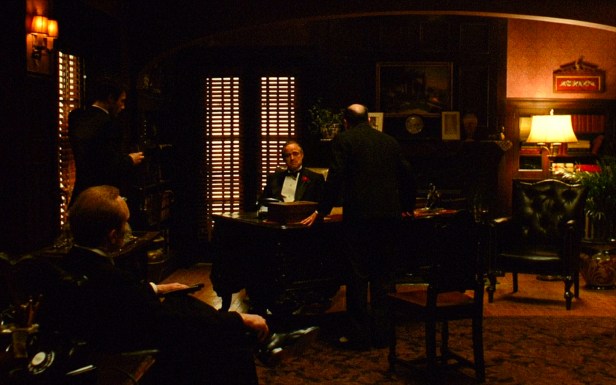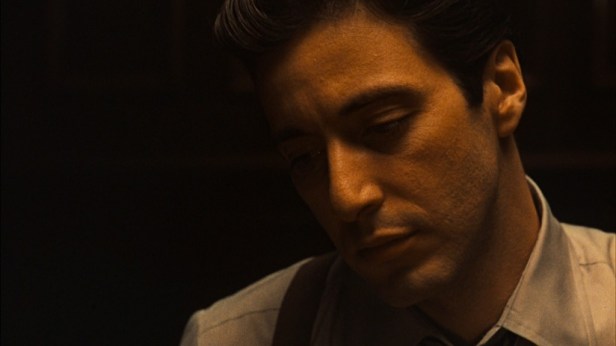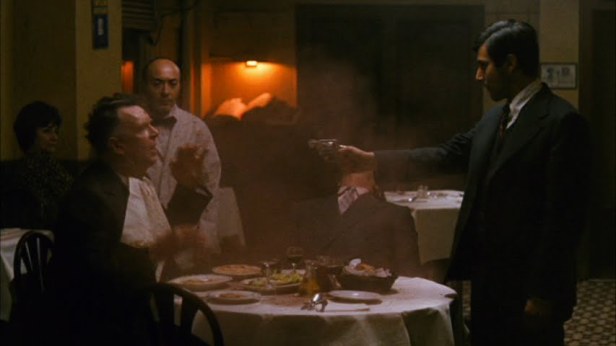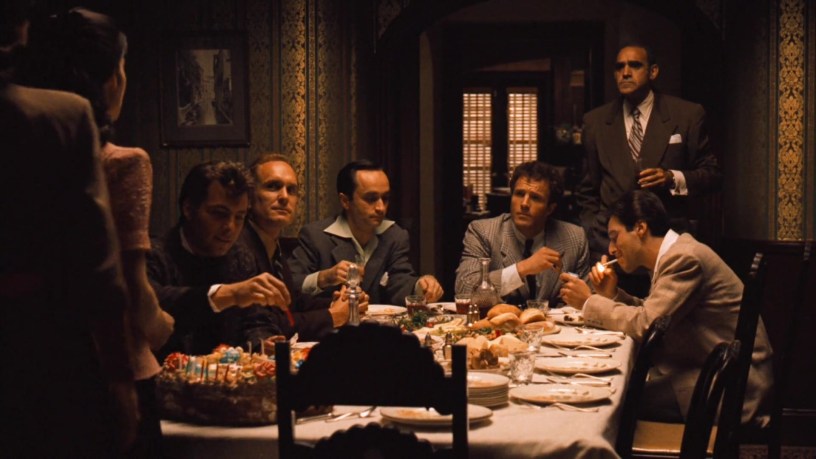The Australian Centre for the Moving Image (ACMI) has recently screened newly restored 35mm prints of The Godfather trilogy of films. The prints came direct, in pristine condition, never previously run through a projector, from Academy Film Archive in Los Angeles. I have watched the trilogy many times – the first film and Part II, many, many times – but this was a rare opportunity for me to experience these groundbreaking works of American cinema on a big screen for the first time and in the format in which they were originally projected.
I believe in cinema. It may sound like an exaggeration to say it aloud but it was not an exaggeration of the experience to say that as the reels of these three films rolled it was like seeing The Godfather Trilogy for the first time. It happened from the very first frame. The familiar strains of Nino Rota’s highly evocative score now filling a packed cinema silent with anticipation. The line from which this entire masterful script sprouts: “I believe in America” spoken into the total darkness by an unidentified voice. The black screen suddenly lit as if by the tiny glow of a match as it comes to rest squarely on a close up of the face of the man who speaks that line, Bonasera, the undertaker, who has come to ask ‘Don’ Vito Corleone (Marlon Brando) for a favour on the day of his daughter’s wedding.

I walked out of that first screening with my senses and feelings in hyperdrive. I think I even mouthed the words to myself, ‘That was fucking incredible.’ It was like I’d just had the most astonishing experience watching a film that was completely new to me. By the conclusion of The Godfather: Part II the afternoon of the following day, I was breathless. I was discovering things in Coppola’s films I’d never really seen before; I was alert to nuances of camera and colour and light I’d simply never noticed, or if I had, had failed to fully absorb.
Gordon Willis’ cinematography, in particular was a revelation, in all its sepia richness and glorious play with light and shadow. Is it possible that I’d never really seen the scene that actually opens Part II, a close-up on Pacino’s then rather magnificent face? Now I was really looking at it, really seeing the new Godfather, Michael Corleone, lit by Willis like a Renaissance portrait; or more specifically, with the luminosity and sensuality of one of Caravaggio’s beautiful boys, skin bathed in a golden glow so subtle and stunning I wanted the projectionist to hit his equivalent of rewind, immediately.

There were also huge emotions. I felt a new level of tension in The Godfather when Michael sits down with the men who have tried to kill his father, Sollozzo ‘The Turk’ and the corrupt police captain in his pocket McCluskey, in a family run Italian restaurant in the Bronx, and turns the tables on them. Pacino is buzzing with nervous energy in this scene, ready to snap. The electricity, the sense of danger, was palpable and profound on a whole new level. I had to gulp for breath and didn’t exhale until he pulled the trigger.

And then I had a new experience when the young Vito Andolini, recently escaped from Sicily, sails into New York harbour early in Part II. For the first time ever watching any Godfather film, I cried. As the camera panned across the faces of these new, hopeful migrants, it was a movement that swept me right into the scene with them, and Rota’s score, escalating in beauty and emotional strokes at this point, heightening every moment, made it all too much to take. I had no choice but to surrender to the feeling and pull out a tissue.
Years of watching these films on DVD, on what can only be described as a pretty average size television screen had clearly diminished something in their presentation for me. Seeing the trilogy in 35mm, in the format Coppola always intended it to be screened in, has transformed my relationship to it.
The medium does matter. It shaped my experience and response. Digital, we are repeatedly told, is supposed to add clarity and brightness, to make a film look better than it originally did. But it’s difficult to imagine that the 35mm film prints acquired by ACMI could have looked any better than they did. The restoration was warm, highly textured, rich and sensual and simply beautiful to look at. There were moments so gorgeous it was like Coppola (and Willis) had breathed life into a painting.
All of the films’ ‘big’ moments were somehow even bigger now.
Brando’s first appearance on screen, stroking a cat as he dispenses ‘godfatherly’ advice to the undertaker desperate for ‘justice’ for his daughter. The wedding party taking place without him beyond his window, each frame filled to bursting with action. Michael’s scenes with Kay (Diane Keaton), more intimate and more loaded, especially his denial of involvement in the death of Carlo at the end of Part I and their confrontation over the abortion in Part II (as an aside, I’d forgotten just how dynamic Pacino and Keaton are together in all their scenes).


One of the most famous death scenes in movie history, the murder of Sonny Corleone (James Caan) out on the Long Island parkway, louder and more brutal than you ever imagined. The Godfather’s operatic denouement as Michael stands as ‘godfather’ to his sister Connie’s (Talia Shire) baby while the killing of the heads of the five families takes place, all the more theatrical and epic in the best kind of way. The scenes of rural Sicily in The Godfather and Part II all brilliant sun-drenched landscapes in contrast with the dimly lit interiors back in New York.
And don’t get me started on the dissolves in The Godfather: Part II. Here they are, finally truly visible as seamless, evocative shifts between Michael in the film’s present and his father Vito (now played by a flawless Robert De Niro) in the film’s past.

For me, the centre of the trilogy has always been Michael’s visit to Cuba in The Godfather: Part II and his discovery that it was his brother, Fredo (John Cazale), who has betrayed him. It’s the point in Michael’s narrative at which he truly slides into the amoral abyss that will swallow him whole by the trilogy’s end.
Amidst the chaos of New Year celebrations in Havana, as the communists begin their overthrow of Batista, Michael grabs his brother and kisses him (effectively the kiss of death) uttering one of the trilogy’s most famous lines: “I know it was you Fredo. You broke my heart.” You can feel Fredo’s dread and Michael’s heartbreak with even greater power and tragedy. And it’s somehow even more profound when you’ve seen it before and you know where this broken heart will lead him.

The big screen even gave me a new relationship with The Godfather: Part III, the trilogy’s often much maligned final chapter. What emerged even more deeply during this viewing is the extent to which Michael Corleone’s life has been wracked by the guilt of ordering Fredo’s murder. This grief fuels Michael’s continuing pursuit of legitimacy and his attempts to redefine his relationships with those he loves most. By the film’s operatic conclusion I was on Michael’s side, then lost in that final lonely shot of him ending his life a tragic broken man who we can’t help but pity.

It’s impossible not to feel all these feelings when the performances are also so much bigger. I exited each screening with a new admiration for each of them – for Brando’s bold brilliance, for De Niro’s warmth and excellent Italian, for Keaton’s beauty and strength, for Caan’s explosive dynamism, for Cazale’s fragile depth. But mostly, I fell back in love with Al Pacino.
Just like Keaton has recently effused in a series of memoirs, with Pacino it’s always about that face and those huge brown eyes in particular. In The Godfather Trilogy his eyes act like a barometer of Michael’s morality. They shift from knowing innocence to chilling menace to heartbreak across the trilogy’s 549 minutes. Watching the three films back to back allows you to really see Pacino at his most masterful and contained. It’s an unforgettable three-act performance made all the more extraordinary because it almost didn’t happen at all. Paramount executives met Pacino’s casting with hostility, especially Robert Evans, who would have preferred Coppola cast someone more conventionally handsome like Ryan O’Neal or Robert Redford as Michael. In hindsight, I’m sure Evans sees the error of his ways.

(I wrote a feature on this exact conundrum for a daily newspaper recently and you can read it here if you feel so inclined:
Like many cinephiles, I have an ever-expanding collection of discs taking over my house that require watching. Then there’s all that other content that’s out there, some of it free and other temptations available at very good prices from streaming sites like Mubi. So many films everywhere that there is almost no reason to ever venture outside my front door.
And yet I do.
Just this weekend I spent almost an entire Saturday cocooned inside the womb-like darkness watching Xavier Dolan’s first three films – I Killed My Mother (2009), Heartbeats (2010) and Laurence Anyways (2012). I’d seen Heartbeats in the quiet darkness of my bedroom but seeing it on the big screen was something else, something even more luscious and more immersive, and it made me love the film even more. Earlier in the week I saw Dolan’s Tom at the Farm (2013), again, in a cinema. Tomorrow night I’ve plans to see my first of probably four films in ACMI’s new season, ‘Martin Scorsese presents Masterpieces of Polish Cinema’, Andrzej Wajda’s Ashes and Diamonds (1958). I’ve never seen it and I’m glad that the first time I do it will be like this.
I had seen The Godfather Trilogy before but I’m also glad I saw it again, like I did, in a cinema – a magical space where everything old is forever new.

You’ve transported me back to when I saw the 3 films back-to-back in a cinema in London, all in one day! What a day that was. Now you’ve scratched the itch again and I shall have to dig out the DVD boxed set and have a feast day tomorrow, turning the phone off and hanging a sign on the living-room door, Do Not Disturb. Lovely review, you brought it all back to life for me. I’ve been twice to Sicily to trace the steps of The Godfather, to the village where the first wedding took place, to Corleone (still a Mafia hideout) and various other places. Best of all was touring backstage at the Opera House in Palermo where the final denouement took place. I’ve stood on those steps so often, hearing the strains of Cavalleria Rusticana, seeing in my mind’s eye Al Pacino’s face as he watched his beloved daughter die. I’ve prowled the backstage marbled passageways and caressed the curtains behind which the bodyguards hid, and best of all, I sat in that chair in the Royal Box at the Teatro Massimo.
Thanks so much for your comment. I am delighted that my writing was able to bring all of that back for you. I’m hoping to visit Sicily for the first time this year and am sure I will have Cavalleria Rusticana in my head for the entire trip.
You’ll love Sicily. Contact Addio Pizzo.com for information on all anti-Mafia stuff there and be guided by them as to where to eat and drink (all places that rebuffed the Mafia). Can I give you the URL to my article on the Theatre (and the Mafia) on Wizzley.com?
http://wizzley.com/the-godfather-and-palermo/
Thanks for the tips! Much appreciated.
On another blog which I cannot find for some reason, you mentioned Corleone as not being the main spot for filming. One of our TV chefs, Gino D’Acompo, has recently been cooking and filming in Sicily, and in this week’s programme, he cooked in the Bar Vitelli, the famous bar in Savoca that stood in for the home of Apollonia. The current Vitelli owner said that the reason Savoca was chosen for was because the Mafia, who controlled Corleone at the time of filming, was asking an exorbitant sum for permission to film there. Coppola refused to pay. Hope this information adds to your fund of knowledge.
Thanks for sharing this information.